#Codiaeum variegatum ‘Petra
Text
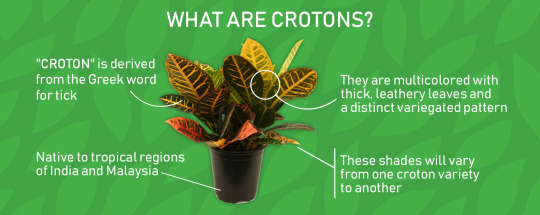
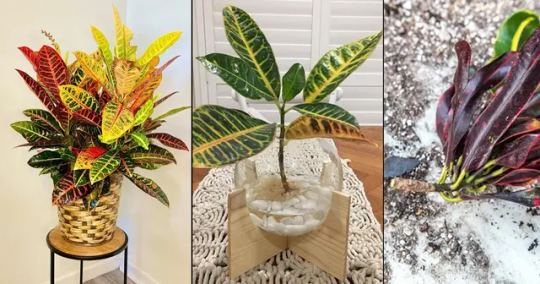
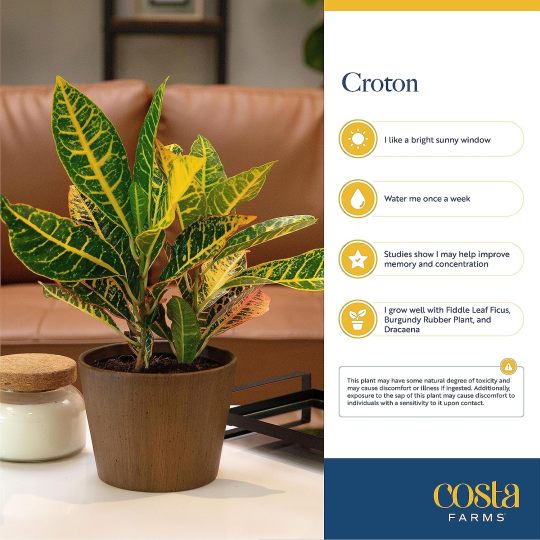
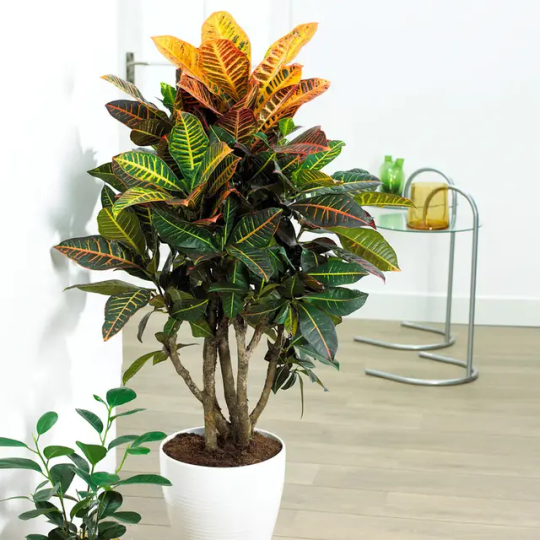

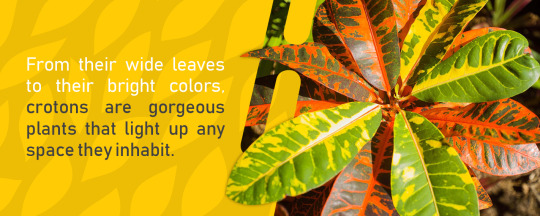
Croton (Codiaeum variegatum ‘Petra)
Croton plants love sunlight! Croton plants develop their best colors when grown in bright light. It will need to be watered deeply every week, but you may need to increase watering if you notice any wilting.
Croton Plant Care: Everything You Need to Know
Indoor vs. Outdoor Growing, Varieties, & More
The primary challenge with croton plant care indoors is maintaining the ideal temperature. If it is too cold, the plant will start losing leaves. However, crotons are well worth the effort for the explosion of color they can provide in a space. Other croton plant benefits (and houseplant benefits in general) include cleaning the air, adding humidity to a space, and improving mood and productivity.
Sun Exposure Full, partial
Soil Type Moist, well-drained
Croton Plant Care
The trick to take care of a croton plant is to provide steady warmth. A well-grown croton plant keeps its leaves down to the soil level. Even croton plants outdoors drop leaves after a cold night. Croton plants also need sun to maintain their vibrant leaf colors.
When caring for a croton plant indoors, low humidity can make the plant particularly susceptible to spider mites. Mist your plants daily to help avoid an infestation. Crotons can be brought outdoors in warm weather, as long as they are properly acclimated to the light and temperature conditions.
Croton plants indoors typically should be placed by your brightest window. A quality potting mix that drains efficiently should suffice. Make sure they're protected from drafts around windows and doors, as well as air-conditioning vents.
Light
Croton plants need a fair amount of sun. Bright, indirect light is best. Some croton plant varieties don't tolerate unfiltered, direct sun as well as others, but they will thrive in dappled sunlight. If the plant is getting insufficient sun, the leaves will turn green.
Water
Keep croton plants evenly moist in the summer. Crotons need about 1 inch of water per week. Reduce watering in the winter to biweekly. Watch the plant for signs that it needs more water, such as wilting young foliage. Increase watering if the wilting noticeably happens during hot weather, but check the top couple of inches of soil with a finger for moisture before you increase water. If it's still moist, hold off on watering. Mist frequently during the growth period.
Soil
A well-drained, moist soil that has been enriched with compost is ideal. This plant prefers humus-rich, acidic soil.
0 notes
Photo

#codiaeum variegatum var. pictum 'Petra'#park#Sapporo#クロトン ’ペトラ’#豊平公園#札幌#Carl Zeiss Makro-Planar T* 2/50
16 notes
·
View notes
Text

Fall Colors
Since I'm in the southern US, where fall is extra summer🥵, this is where I get to see fall colors.🍂 My mom's Croton 'Petra' did not fare well inside last winter❄, and she still hasn't really bounced back as much as I hoped she would. Just do your best, honey🍯!
#plantblr#plants#houseplant#houseplants#my plants#croton#petra croton#croton petra#codiaeum variegatum#porch plants#fall colors#veins
3 notes
·
View notes
Photo



6/29/17: Codiaeum variegatum or Garden Croton; a flowering plant species native to “Indonesia, Malaysia, Australia, and the western Pacific Ocean islands”, with separate male and female inflorescences (groups of flowers) on the one plant. Known and popular for it’s unique, brightly colored leaves which come in several differing cultivars. It is a member of the Euphorbiaceae family (which I found to be interesting - most of the Euphorbes I cared for working in a greenhouse were not similar to this! But plants are immensely diverse!). This species prefers tropical climates, so it won’t survive in temperatures below 55*F or 13*C. This also means it needs to be kept more moist and watered in humid/hot environments or during the summer, while cutting back to watering 2 or 3 times a week during the winter or in a cooler environment.
-Jessica
#plants#indoor plants#tropical#humid#tropical plants#croton#garden croton#croton petra#euphorbia#euphorbiaceae#nature#colorful#colorful leaves#beautiful houseplants#codiaeum#variegatum
21 notes
·
View notes
Photo

check out the inflorescence on this croton!
#plants#garden croton#codiaeum variegatum#plantblr#inflorescence#flower stalk#variegated plants#croton#blooms#houseplant#croton petra#tropical plants#flowers#my photos#los-plantalones
11 notes
·
View notes
Text
Plant Index
I figured that every plant journal really should start with a list of plants that gets updated. So here is my own list of plant children :)
Most of my acquisition dates are rough estimates, but I am hoping future me keeps up with the idea!
In Propagation
Echeveria ‘Mensa’ Offspring (October 21, 2019)
Unknown Succulents #1
Wandering Jew -- young branch -- January 16, 2020
Sansevieria Trifasciata ‘Laurentii’ (?) -- -- January 19, 2020
Unknown Succulents #2 -- -- January 19, 2020
Unknown Lipstick Plant -- -- January 19/ Jan 26, 2020
ZZ plant -- March 19, 2020
Epipremnum Aureum ‘Golden Pothos’ -- March 16, 2020
Anthurium -- March 20, 2020
Monstera Adansonii -- Cheesy Jr - May 13, 2020
Monstera Adansonii - Mini Cheesy - May 13, 2020
Monkey Puzzle Tree -- May 25, 2020
Monstera Adansonii -- Swiss Jr --
Persea Americana Experiment (Avocado Seeds)
Persea Americana -- Alpha -- January 14, 2020
Persea Americana -- Beta -- January 14, 2020
Persea Americana -- Gamma -- January 14, 2020
Persea Americana -- Delta -- January 19, 2020
Persea Americana -- Epsilon -- January 26, 2020
Persea Americana -- Zeta -- January 26, 2020
Persea Americana -- Eta -- January 26, 2020
Persea Americana -- Theta -- February 2, 2020
Persea Americana -- Iota -- February 2, 2020
Persea Americana -- Kappa -- February 10, 2020
Persea Americana -- Lambda -- February 23, 2020
Persea Americana -- Mu -- February 23, 2020
Persea Americana -- Nu -- February 23, 2020
Persea Americana -- Xi -- March 30, 2020
Persea Americana -- Omicron -- March 30, 2020
Persea Americana -- Pi -- March 30, 2020
My Plants
Sensitive Plant -- June 1, 2020
Colacasia -- May 29, 2020 (?)
Moss Terrarium -- Pine and Company -- May 19, 2020
Hardy Maidenhair -- William --May 18, 2020
African Violet -- May 2, 2020
String of Dolphins - March 15, Potted: April 6, 2020
Fairy garden -- April 24, 2020
Mini sensitive plant -- April 24, 2020
Angel Wing Begonia -- April 24, 2020
Silver Satin Pothos - Sylvia - April 3, 2020
Phalaenopsis -- March 30, 2020
Epipremnum Aureum -- Marble Queen -- Dec 1, 2019, March 22, 2020
Philodendron ‘Jungle Boogie’ -- March 16, 2020
Sedum Morganianum -- Burro’s Tail -- March 15, 2020
Unknown Hawarthia -- -- N/A
Cotyledon tomentosa -- -- Feb 28, 2020
Hoya Kerrii --Serduszko -- Feb 22, 2020
Maranta Leuconeura -- Melaine -- Feb 22, 2020
Epipremnum Aureum -- ‘Marble Queen’ -- Feb 20, 2020
Microsorum Musifolium -- Kraken -- Feb 20, 2020
Monstera Deliciosa -- -- Feb18, 2020
Tillandsia Bulbosa -- -- Feb18, 2020
Philodendron Cordatum -- Serpentine pt 2-- Dec 1, 2019, Potted: Feb 10, 2020
Unknown plant bulbs -- -- Feb 10, 2020
Alocasia Sarian -- -- Feb 8, 2020
Tillandsia Fasciculata Tricolor -- -- Feb 8, 2020
Tillandsia butzii -- -- Feb 8, 2020
Tillandsia Ionantha scaposa -- -- Feb 8, 2020
Mini Phalaenopsis -- Child #1 -- Feb 2, 2020
Mini Phalaenopsis -- Child #2 -- Feb 2, 2020
Calathea roseopicta -- Roza -- Feb 2, 2020
Calathea picturata -- Margaret -- Feb 2, 2020
Peperomia argyreia -- Wanda -- Jan 26. 2020
Epipremnum Aureum ‘Neon' -- -- Dec 1, 2019, Potted: Jan 26, 2020
Calathea Zebrina -- Cecilia -- January 25, 2020
Philodendron Cordatum -- Serpentine -- Dec 1, 2019, Potted: Jan 19, 2020
Epipremnum Aureum ‘Jade’ -- Pheonix -- Dec 1, 2019, Potted: Jan 19, 2020
Unkown Plant Bulbs -- Alara, Ellie, N/A-- Jan 19, 2020
Fittonia -- -- Jan 4, 2020
Alocasia Macrorrhizos 'Stingray' -- Felicia -- Dec 31, 2019
Selaginella Kraussiana -- Frosty -- Dec 30, 2019
Nephrolepis Exaltata -- Cotton Candy Fern -- Dec 30, 2019
Philodendron Rojo Congo -- -- December 30, 2019
Marimo Moss Ball -- Chance -- Dec 29, 2019
Crassula Ovata -- Jade -- Dec 17, 2019
Unknown Succulent #1 -- -- Dec 17, 2019
Monstera Adasonii -- Swiss -- Dec 15, 2019
Hoya Carnosa -- Baby Hoya -- Dec 5, 2019
Hoya Carnosa -- -- Dec 1, 2019
Chlorophytum Comosum -- Spider Plant #1-- Oct 21, 2019
Iresine Herbstii -- Bloody Mary, Mary -- Oct 16, 2019
Mini African Violet -- Viola -- Oct 16, 2019
Echeveria ‘Mensa’ -- -- Oct 16, 2019
Hendera Helix -- Ivy -- Oct 16, 2019
Monstera Adasonii -- Cheesy -- Nov 21, 2019
Codiaeum Variegatum ‘Petra’ -- Petra -- Nov 19, 2019
Sansevieria Cylindrica -- Needle -- Nov 9, 2019
Tillandsia Circinata -- Air plant -- Late Summer 2018
Philodendron Hederaceum ‘Brasil’ -- -- Late Summer 2018
Bromeliaceae Vriesea -- Stripe -- Mid Summer 2018
Tradescantia Pallida -- Wandering Jew -- Spring 2018
Philodendron Selloum -- Antler -- Spring 2018
Bromeliaceae Guzmania -- Bromeliad -- Early Dec 2017
Mini Phalaenopsis -- Mother Orchid -- Mid Dec 2017
Stromanthe -- Triostar -- Summer 2017
Calathea Lancifolia -- Rattlesnake -- Summer 2017
Monstera Deliciosa -- Monstera -- 2016
Gardening Attempt
hosta #2 -- May 29, 2020
Red leaf banana -- May 26, 2020
Hosta -- May 11, 2020
Woodland Strawberries -- May 4, 2020
Pine Berry -- April 24, 2020
Dark Eyes Fuchsia -- March 30, 2020
Unknown Fuchsia -- March 30, 2020
Blaze Fuchsia -- March 30, 2020
Oregano -- March 30, 2020
Parsley -- March 30, 2020
Basil -- March 30, 2020
Strawberry -- March 30, 2020
Green onion -- March 13, 2020
My “Shared” Plants
African Palm (?) -- June 1, 2020
Codiaeum Variegatum ‘Petra’ -- June 1, 2020
Epipremnum Aureum ‘Golden Pothos’ -- March 16, Potted: May 23, 2020
Monstera Deliciosa -- Monsti -- Potted: January 2, 2020
Spider Plant #2 -- -- Potted: December 29, 2019
Christmas Cactus -- -- December 1, 2019
Coffee Plant -- -- Nov 19, 2019
Epipremnum Aureum ‘Golden’ -- -- November 19, 2019
Alocasia x Amazonica -- Alocasia -- October 19, 2019
9 notes
·
View notes
Video
youtube
Croton Petra (Codiaeum Variegatum) Care & Growing Guide - Plant Mom Care
0 notes
Photo

M and I have a problem - we're both addicted to plants. Both houseplants and anything for the garden! We come back with something new almost every time we stop into Home Depot. Last time it was a bamboo plant for the bathroom. Yesterday we got this beautiful croton 'Petra' (codiaeum variegatum). We both saw the yellow, red and green variegated leaves and were LIKE WE NEED THIS. Last I counted we had 20+ houseplants, with a couple of them outside enjoying the rainwater and sun for now. Good thing I also got a bigger watering can 😂 https://ift.tt/33sLabt
0 notes
Photo

M and I have a problem - we're both addicted to plants. Both houseplants and anything for the garden! We come back with something new almost every time we stop into Home Depot. Last time it was a bamboo plant for the bathroom. Yesterday we got this beautiful croton 'Petra' (codiaeum variegatum). We both saw the yellow, red and green variegated leaves and were LIKE WE NEED THIS. Last I counted we had 20+ houseplants, with a couple of them outside enjoying the rainwater and sun for now. Good thing I also got a bigger watering can 😂 https://ift.tt/33sLabt
0 notes
Text
4 through 8 February 2019
It’s been a busy week in the garden. We are getting back to normal after the Heralding Spring event. I finally had an opportunity to try our new caterers and their food is delicious.
Medicinal plants will be done every fortnight going forward...so next week there should be a new one.
We have a new intern for three weeks, Harriet. She’s been a great help and a nice boost to the team.
I am still working through all the interpretation in the garden, though an end is nigh, thankfully. I started replacing a few raised beds in the pharmaceuticals area. That should be finished next week. I commenced work on the Galanthus collection in the garden. I drew up some quick planting plans, in the rain, so we know where we think they are now. I will look at dividing, moving and expanding the collection.

Plant ident on beautiful leaf patterns by Franziska Stampfli:
Acanthaceae Ruellia portellae
Boraginacae Pulmonaria officinalis
Euphorbiaceae Codiaeum variegatum ‘Petra’
Geraniaceae Pelargonium elongatum
Malvaceae Lavatera arborea ‘Variegata’
Marantaceae Maranta leuconeura var. kerchoveana
Piperaceae Piper ornatum
Primulaceae Cyclamen hederifolium
Rutaceae Citrus x limon ‘Variegata’
Xanthorrhoeaceae Gasteria croucheri
I enjoyed a busy social week: Raphael was visiting from Munich, Pasquale was in town from Florence, Denis invited me to see Káťa Kabanová (an opera in three acts, with music by Leoš Janáčekat) the Royal Opera House Wednesday, and Thursday I caught up with my colleague Robert after work.
Thursday there was a one-day-only art exhibition in the garden, done by art students. This was my favourite, three different views through three differently shaped viewfinders. This was my favourite view, at that moment. I would love to see how that would change through the year with the plants.

Plant of the week
Lamiaceae Marrubium vulgare L.

common name(s) - white horehound, horehound, hound's bane, marrube, marvel, maw-roll
synonym(s) - Marrubium album Garsault [Invalid]; M. apulum Ten.; M. ballotoides Boiss. & Balansa; M. germanicum Schrank ex Steud.; M. hamatum Kunth; M. uncinatum Stokes; M. vaillantii Coss. & Germ.; M. vulgare subsp. apulum (Ten.) H.Lindb.; M. v. var. apulum (Ten.) K.Koch; M. v. var. caucasicum K.Koch; M. v. var. gossypinum Nábelek; M. v. var. lanatum Benth.; M. v. var. microphyllum Baguet; M. v. var. oligodon Rech.f.; Prasium marrubium E.H.L.Krause [Illegitimate]
conservation rating - Near Threatened
native to - North Africa, Europe and western Asia
location - perfumery, accession _____
leaves - oppositely-arranged densely covered in woolly hairs; lower leaves have longer petioles than the upper ones; egg-shaped or almost rounded in outline and crinkly in appearance; bluntly toothed margins and a rounded tip
flowers - white tubular flowers borne in dense clusters in the axils of the upper leaves; two-lipped, the upper lip being divided into two lobes and the lower into three lobes; surrounded by a persistent green calyx tube of fused sepals with ten narrow teeth; fruit contains four seeds or nutlets enclosed in the old flower calyx, which has ten backward-curved teeth or spines
habit - upright or spreading, evergreen perennial, much-branched herb with stems square in cross-section, up to about 600mm tall, more or less covered in woolly interwoven hairs
habitat - waste places, roadsides
pests - leafhoppers
disease - none found
hardiness - to -10ºC (H4)
soil - poor, dry soil, well-drained, neutral to alkaline
sun - full sun
propagation - seed, basal cuttings in late spring, division in spring
pruning - if cut back after flowering, it will normally produce a second crop of leaves
nomenclature - Lamiaceae - gullet, λαιμος the name in Pliny refers to the gaping mouth of the corolla (Lamiaceae = Labiatae); Marrubium - the name in Pliny, either from the Hebrew, marrob, for the biter-juice, or derived from Marrubium or Maria urbs, an ancient town of Italy; vulgare - usual, of the crowd, common, vulgar
NB - tends to invade land that has been disturbed, overgrazed or previously grazed by sheep in the Americas and Oceana and; is used as a natural grasshopper repellent in agriculture; is used to make hard lozenge candies; also used in beverages, brewed and made into Horehound Ale, an appetizing and healthful beverage, much drunk in Norfolk and other country districts, also steeped as tea (similar to the Maghrebi mint tea), and in the rock and rye cocktail; considered by folk medicine to aid digestion, soothe sore throats, and relieve inflammation; mentioned in conjunction with medicinal use dating at least back to the 1st century BC, where it appeared as a remedy for respiratory ailments in the treatise De Medicina by Roman encyclopaedist Aulus Cornelius Celsus who lists it as a remedy for expelling worms in farm animals in his important first-century work On Agriculture; has appeared for similar purposes in numerous herbals over the centuries, such as The Herball, or, Generall historie of plantes by John Gerard, and Every Man His Own Doctor: or, The Poor Planter’s Physician by Dr. John Tennent.
References, bibliography:
CABI [online] https://www.cabi.org/isc/datasheet/119607 [8 Feb 19]
Gledhill, David, (2008) The Names of Plants, fourth edition; Cambridge University Press; ISBN: 978-0-52168-553-5
IUCN [online] https://www.iucnredlist.org/species/203247/2762568 [8 Feb 19]
Plant List, The [online] http://www.theplantlist.org/tpl1.1/record/kew-120952 [8 Feb 19]
Plants for a Future [online] https://pfaf.org/user/Plant.aspx?LatinName=marrubium+vulgare [8 Feb 19]
Shoot Gardening [online] https://www.shootgardening.co.uk/plant/marrubium-vulgare [8 Feb 19]
Wikipedia [online] https://en.wikipedia.org/wiki/Marrubium_vulgare [8 Feb 19]
0 notes
Text
Jan. 11th-17th
During the first day of class, we immediately delved into the art and science of field sketching. Dr. Moore first introduced us to the basics of field sketching and what it entails. He showed the uses of being able to blend ones scientific skills and the importance of bringing art into the matter; this sort of mixing of skills can result in creating field guides. He also demonstrated the importance of accurate note-taking and how some of the older examples have led to the identification of new species.
Basic art techniques and skills were introduced later by Dr. Lemeh. She demonstrated things such as cross hatching and stippling, among others, and how to create a gradient with them. Different types of art mediums and their variations (graphite and the softness or hardness) were also briefly discussed. I was already familiar with many of these subjects because of the classes I had taken in high school.
Throughout the week, I’ve worked on the skills packet as well as as the drawing of my collected specimen. In doing this, I have started to reacquaint myself with many of the tools commonly used in art and drawing. The assignment has shown me that there is a lot that I’ve lost but I know soon it will improve once again.
The specimen I collected was a leaf from a plant commonly known as Croton Petra (Codiaeum variegatum petra). The leaf was collected from under one of the vibrantly colored plants on campus. The croton petra is native to some western Pacific islands as well as southern Asia. These plants require strong sunlight and lots of humidity. Some of the plants can grow up to ten feet high, but many varieties used for landscaping are much shorter, being of the dwarf variety. Different varieties show different colors; the ones on campus exhibit bright green, yellows, reds, and oranges while other varieties may have pinks or purples.



0 notes
Photo

Codiaeum variegatum 'Petra' - 💗🌺🙏🏻 ---------------------------- #amazing #bloom #beautiful #blossom #flower #flowers #happiness #instaflowers #instagood #love #pretty #universe #plants #bringyourownheart #springtime #spring #croton #pollen #cosmos #greenthumb (at Junius Heights, Dallas)
#love#flower#spring#instaflowers#universe#pollen#plants#croton#amazing#happiness#cosmos#pretty#springtime#greenthumb#blossom#beautiful#bringyourownheart#bloom#flowers#instagood
0 notes
Link
0 notes